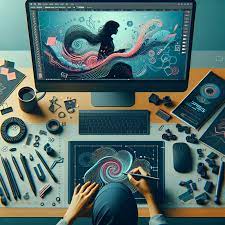“A compatible choice of device will streamline your business and workflow effectively without any technological hiccups.”
Every graphic designer needs a device that would be most suitable for them based on-
- Workflow
- Location
- Style
Coinciding with these conveniences, any graphic designer is bound to choose a laptop or a desktop, or both. But whatever device or OS you choose as a designer, you must ensure that the designing tools can be installed on the system without much technical difficulties and the files can be downloaded and stored.
Every graphic designer prefers a device based on the following criteria –

Performance
As you start operating the system, desktop and laptop has the tendency of releasing heat. However, with laptop the heat dissipation is even more. The components give off heat, which makes operating on it difficult. They do not run as fast as desktop components which prevent heat from being created.
Whereas the continuous workload on desktop computers can heat the system. Heat dissipation of a desktop is higher than the laptop. This is because desktop computers run faster, have a much higher speed in processing and in quality too. Laptop processors do not have more than 60% of the performance when compared with desktops.
Graphics Card
The graphics card or GPU in desktops are much faster than laptop GPUs which only have a maximum of 80% of speed generally. It is also seen that desktop GPUs are of much better quality than laptop GPUs.
Durability
Every laptop and desktop computer has comparable durability. Both the devices are made of steel or plastic. In the case of laptops, the whole system has more durability due to its mobility. Though the size of the monitors is limited. Though you can attach an external monitor if you are not traveling anywhere. But the screen size of the laptop is what it is attached to.
With desktop monitors, there can be a conflict with durability. They can take a knock two. But it’s easy to replace the monitor for a better one, unlike laptops which is not possible.
Robustness
The configuration of the laptops is done with solid-state drivers or also called SSDs. The SSDs are more durable in a laptop if it is dropped, broken, or anything. But laptops as a whole do not endure the robustness of a desktop computer.
Whereas, desktop computers have solid robustness with maximum heat dissipation, CPU, and GPUs. You fix it by swapping out components is a much more time-saving and budget-friendly job. If any single part is failing or is no longer adequate, you can change out parts yourself. Desktops have multiple configuration options available for them without the need for customization.
Portability
Laptops and desktop computers have a major difference in terms of portability. If your job description includes traveling between workplaces, clients, sites, then a laptop is most suitable for you and your only choice as a graphic designer.
But, if your job description is more restricted to one place of movement, then a desktop computer is an option.
Though, a combination of both laptops and desktops is the most effective choice for your work in any graphic design service provider’s office if you have the budget and the workspace.
Upgradability
The laptops use custom-built parts which are hard to upgrade or replace. Minimum tweaks cannot be adjusted with the help of a technical expert present in the room for a laptop. This will drain your pocket and take much more time.
Whereas, desktop computers use modular-sized parts. It can be upgraded easily by replacing them and are cheaper too. You can do the process in less time, save your money, and it is much easier too.
Storage Capacity
All desktop computers have a storage capacity that can be upgraded easily using more RAM (Random Access Memory). It is seen that at desktop-level graphic designing work may slow down while processing photos, rendering, or editing videos. You can easily ramp up the speed by adding more memory. There are 3 more slots available in desktops for RAM for you to upgrade the memory.
Whereas with laptops, you can upgrade the memory. But, it does not have so many available slots.
Budget
A laptop for graphic designers might be too expensive. Whereas, desktop computers are much more affordable. Graphic designers have a higher chance of finding a desktop that will suit their budget, as well as support other functionalities too.
To conclude,
While choosing the right device for graphic designing, the first three questions that come to mind are-
- What do you do?
- How much work do you do?
- Where do you do it?
The answers to these questions will lead you to choose what is most appropriate for your workspace- a laptop or a desktop computer.
Every graphic designer has a preference of their own – power, versatility, ease for travel, budget, and so on. To fill these gaps, a laptop, a desktop computer or a combination of both can be handy and budget-friendly to get optimized results.
Desktop computers have dominated characteristics, like-
- Graphic design friendliness
- Runs more general software
- Easily upgradeable components
Whereas laptops have some features too to consider, like-
- Portability of device
- Can attach an external storage drive to store all your files
The combination of both the laptop and desktop might be a potential choice to enjoy the best of both worlds.












